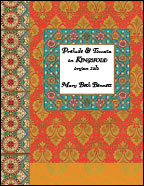|
Composer Mary Beth Bennett
Price $12.50 (U.S.) Released 6/2015
Use Voluntary, Recital
Hymn Tune KINGSFOLD
Difficulty Mod. difficult
Catalog no. 160-824
Order now!
Order PDF download!
Description
This two movement treatment of the English folk hymn Kingsfold was commissioned for the 2015 Pittsburgh Mid-Atlantic Regional Convention of the American Guild of Organists. The expressive prelude begins with a lush, broad treatment with the melody presented in the pedal on a 4' stop. A brief, celeste interlude leads to a flowing, plainchant-like setting before the mysterious celeste music returns to close. The ebullient toccata takes the hymn through a variety of keys with a perpetually moving texture. "...This piece combines sophisticated counterpoint, rhythmic verve, and a sophisticated harmonic palette...." (AAM Journal)
|
|


Prelude 
Toccatta 
Review
Mary Beth Bennett is on the adjunct faculty of the Department of Music of the University of Richmond and is Director of Music at First Presbyterian Church of Gloucester, Va., where she is active as a performer, improviser, and composer. Her Prelude & Toccata on KINGSFOLD was commissioned by the American Guild of Organists for the 2015 Mid-Atlantic Regional Convention in Pittsburgh, Pa. The Prelude and Toccata are completely independent pieces and are a suitable length for a prelude and postlude pair. The two can also be played together as a diptych with a striking contrast of mood. I am particularly impressed with the variety of contrapuntal techniques that Bennett employs to get the most out of this sturdy tune. The Toccata alone contains canon at the octave, the theme in augmentation in canon with the original version, and the simultaneous playing of the tune with its inversion (something also used by Clarence Dickinson in his piece The Joy of the Redeemed). In addition to these devices, Bennett uses harmony and rhythm creatively. Her harmonic language is influenced by the modern French school, yet it never becomes intensely dissonant. Minor-third relationships abound in the Prelude, especially in the highly chromatic central section where the melody is altered into a mode similar to the octatonic scale. The harmony in the Toccata is more firmly planted in E minor, but twice detours into E-fiat minor for the softer sections of the work. The rhythmic complexity of this work is perhaps even more interesting than the harmonic language. At the opening of the Prelude, she sets the tune, with its two eighth-note upbeats at the beginning of each phrase, against an original countermelody whose phrases begin on the first beat of the bar and emphasize the second beat, in the manner of a sarabande. This opening section is rather simple and calm, but this rhythmic offsetting creates an overlapping of phrases that blurs the meter. Thus, the theme is introduced clearly yet in a complex way made all the more effective by the beauty of a solo 4' flute in the pedal against a rich, low tessitura in the manuals. The central section of the Prelude uses mixed meter, with a frequent appearance of 7/8 time, again blurring the meter and pushing the music towards a sense of timelessness. While the Toccata is in a clear 4/4 meter throughout, the accents in the accompaniment and melody often conflict, with the main accompaniment figure grouped 2 + 3 + 3 and the Toccata theme (not the hymn tune which enters later in the pedal in the original rhythm) is grouped 3 + 3 + 2. This combination gives a remarkable vitality to this Toccata. The driving eighth notes are only abandoned during the softer section employing inversion. This makes the final two pages, when the theme, countermelody, and accompaniment return together (with the theme in canon with its own augmentation!), all the more exciting. This piece combines sophisticated counterpoint, rhythmic verve, and a sophisticated harmonic palette. I was not familiar with Dr. Bennett's music before now, but I hope to encounter more of it. …. I hope that she gains greater recognition and support as a composer of distinction." --AAM Journal, September 2017
|



